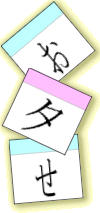|
A special treat for all those beginners about to start studying
Japanese for the very first time - an easy technique to help you
memorise the two japanese alphabets (hiragana and katakana) in about
3 hours each.
If you think back to the days when you first started the English
alphabet as a kid, and to how long it took you to learn by copying the
shape of the example and repeating it endlessly, and now despair at the
prospect of having to do it all over again. And not simply with one
alphabet, but with two, both of which have almost 50 'letters'! Well,
thankfully, you've developed your learning curve a little since then,
and you should be able to try it this way at a little faster pace.
Having said that, this will only teach you to read the
alphabets, and learning to write them will only come later with lots
more practice. But after learning to read them using this technique,
you'll find it a matter of hours, rather than weeks, before you'll be
able to write them too! If, after reading this page, you still can't
quite see how this technique works, then probably you're one of
the unlucky one out of ten for whom this technique won't work - this
technique employs a particular type of mental conjuring, which some
people just can't get. Our apologies to you...
1. Print, cut & label
Print the flashcard sheet, and cut them along the lines. The colour
strip at the top of each card is to indicate which way up the card
should be read - if you really want to make life hard for yourself,
you can cut it off! Shuffle the pack and then sit down with a reference
chart and write the english equivalent on the back of each card lightly
in pencil. By the way, this doesn't count in the 3 hour 'time limit' -
how naughty of us to include fineprint in our too-good-to-be-true deal!
2. Start drinking
Come back the next day with a like-minded beginner, and a tray of
drinks (for you non-drinkers, just relax as much as possible). Trying
to learn this way in a classroom or in a very formal atmosphere won't
help you at all here, but doing this with a friend or two definitely
will.
3. Pull out any cards you vaguely recognise
Having gone through the flashcard pack yesterday, writing the english
on the back of each card, might perhaps have stuck one or two cards in
your mind as in some way distinct from the rest. Probably a couple of
cards seemed nightmarishly complicated, and for that reason alone,
they stuck in your mind. Maybe you even remember the english for them
too! Well, pull these few cards out (if there aren't any you remember,
don't fret!) and stack them separately.
4. Spread the rest out
Now comes the 'image technique' bit. Glance over the cards and see
whether any vaguely resemble the shape of an object. Then once you have
made the mental connection between the shape in your head, and the
shape on the card, you need to find a way to link the two together
using the sound of the english reading. Anything, however dumb
it may seem, that helps you mark out a card as different from the
others, is what you are trying to find. Take a look at the examples
below, and see if you can follow the twisted logic:
 |
 |
hi: This one kind of looks like a smiling face, which of course goes hee-hee. |
 |
 |
 |
 |
ta: If you look hard, you can kind of fit the letters t and a into the shape. |
 |
 |
 |
 |
ki: This one's easy - it's got the skeleton shape of a door key. |
 |
 |
 |
 |
ri: Another easy one - if you turn the card upside down, you can make out the letters r and i. |
 |
 |
5. Memorise those
If you could imagine how those examples worked, then at least you have
probably memorised those four examples. So add them to any other cards
you vaguely remember (that you pulled out before), and flick
through them quickly a few times and see whether any of those have
stuck in your mind yet. Chances are, they have (?).
Repeat steps 2 to 4
Go on - now you've started, you might as well continue and see how
many you can find daft pictures for. That's where the drink (or at
least a relaxed atmosphere and a daft friend!) might prove helpful.
Every time you've accumulated
five or six cards add them to the pack, and go through it a few times.
Keep going - good luck!
For those wanting to start a little kanji character study, then why
not pay a little visit to the Computer Guide,
for details on some very handy free study software.
|
 |

Hiragana
flashcards
Katakana
flashcards
|
